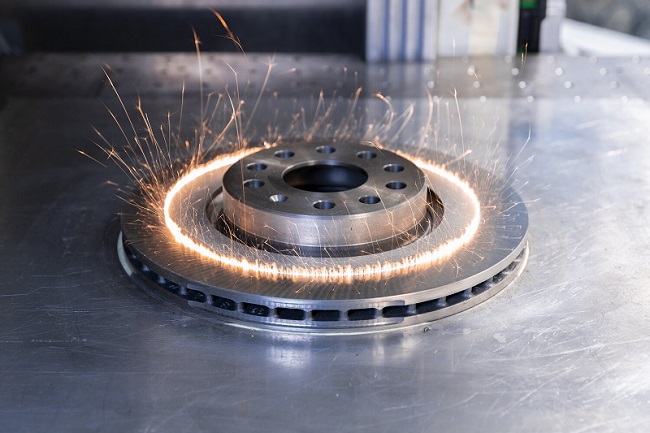In the past, sandblasting has been a necessary part of production in a number of industrial processes. Now, the process may be replaced with a faster, cleaner, and more environmentally friendly process. A team from the Fraunhofer Institute for Material and Beam Technology IWS developed the technology LIGHTblast, which, in addition, is now being transferred to the semiconductor manufacturing, automotive supply, and other industries.
“This is like sandblasting at the speed of light,” said Patrick Herwig, head of the Laser Cutting Group at Fraunhofer IWS. Herwig’s team developed the LIGHTblast method, which uses lasers to clean and structure surfaces in manner more precise and cost-effective than conventional modalities.
“Considering the entire production chain, our process is less expensive than classic sandblasting when used in series production,” Herwig said. “We are certain that laser technology will pay off for companies.”

A method developed at Fraunhofer IWS uses high-energy light instead of sand grains to clean and roughen surfaces, for example the surface of brake discs. The method increases cost efficiency, environmental compatibility, and process speed compared to existing methods such as sandblasting. Courtesy of René Jungnickel/Fraunhofer IWS.
Fraunhofer IWS is currently preparing initial application examples with various end users. The technology has considerable market potential as the use of classic sandblasting systems is increasing.
In manufacturing, sand particles may be embedded into a treated surface and remain as a defect even after intense cleaning. In conventional processes, a jet of compressed air accelerates sand at high speed onto the target surface. The sharp-edged sand particles tear away parts of the surface, causing its sharp edges to wear away and mix with the resulting dust. With each use, the blasting medium contaminates more and more. The process result continuously deteriorates until, ultimately, the mixture must be disposed of, which pollutes the environment and causes additional costs.
Rather than a stream of sand grains several centimeters wide, LIGHTblast uses a laser beam with a diameter smaller than 50 µm. “In a sense, we are working with a scalpel instead of a club,” Herwig said.

As well as its precision, the process can be automated more easily with positive effects on quality, process control, and occupational safety. It removes a number of pre- and post-processing steps. The light-based processing doesn’t require any chemicals for cleaning, only processes the desired surfaces, and consumes neither sand nor material for masking and therefore reduces hazardous waste and waste from adhesive tape waste. The laser beam vaporizes parts of the surface; the expanding vapor carries away solid components and also achieves a defined roughness.
The technology is currently being transferred to industry. For example, Fraunhofer IWS and a partner are further developing the process to structure hard material coatings using laser technology, and to improve on the costs and environmental compatibility associated with the finishing process.
Brake discs are another surface for which the technology is actively being used.

The laser blasting system precisely processes only the desired surfaces, consuming neither sand nor material for masking, thus saving hazardous and tape waste. Courtesy of René Jungnickel/Fraunhofer IWS.
“Every brake disc is different,” said René Bischoff, CTO at C4 Laser Technology, a company located near Dresden. “Factors such as the chemical material composition, cooling rates, the condition of the machining tools, or the graphite structure near the surface are just a few parameters exerting a considerable influence on the coating process of gray cast iron surfaces.
“Together with Fraunhofer IWS, we have found a way to standardize the friction band surface condition of the brake disc blank before coating. Thus, we succeeded in making the normalization process fully automatable as well as cost-efficient and in increasing the process capability.”
The process in this use case contributes to an affordable brake disc with significantly extended service life that ensures that less particulate matter will be produced in road traffic.
In general, the new method can be applied wherever components need to be cleaned, pre-structured, or roughened for subsequent coating. Further development steps are planned for this purpose.